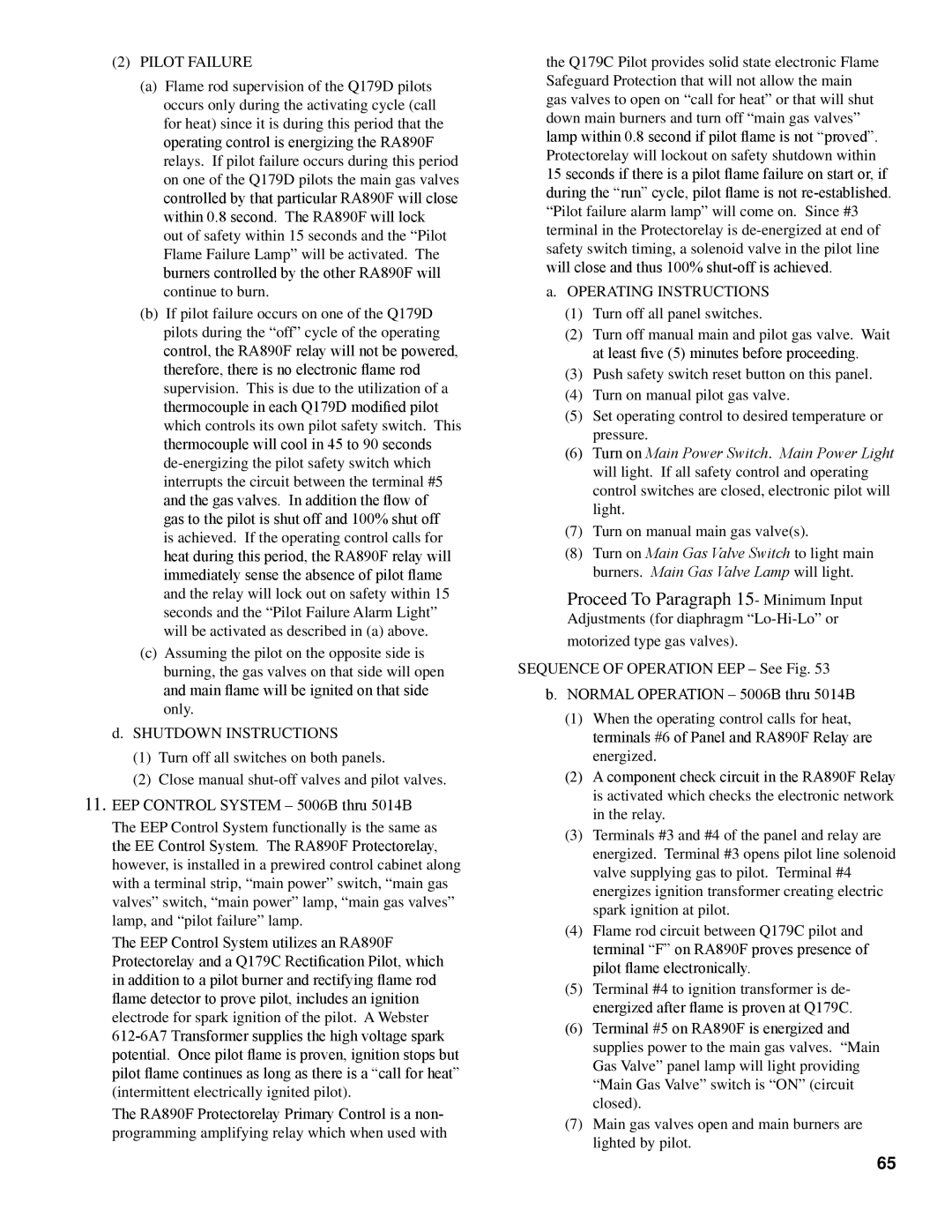(2)PILOT FAILURE
(a)Flame rod supervision of the Q179D pilots occurs only during the activating cycle (call for heat) since it is during this period that the operating control is energizing the RA890F relays. If pilot failure occurs during this period on one of the Q179D pilots the main gas valves controlled by that particular RA890F will close within 0.8 second. The RA890F will lock out of safety within 15 seconds and the “Pilot Flame Failure Lamp” will be activated. The burners controlled by the other RA890F will continue to burn.
(b)If pilot failure occurs on one of the Q179D pilots during the “off” cycle of the operating control, the RA890F relay will not be powered, therefore, there is no electronic flame rod supervision. This is due to the utilization of a thermocouple in each Q179D modified pilot which controls its own pilot safety switch. This thermocouple will cool in 45 to 90 seconds
(c)Assuming the pilot on the opposite side is burning, the gas valves on that side will open and main flame will be ignited on that side only.
d.SHUTDOWN INSTRUCTIONS
(1)Turn off all switches on both panels.
(2)Close manual
11.EEP CONTROL SYSTEM – 5006B thru 5014B
The EEP Control System functionally is the same as the EE Control System. The RA890F Protectorelay, however, is installed in a prewired control cabinet along with a terminal strip, “main power” switch, “main gas valves” switch, “main power” lamp, “main gas valves” lamp, and “pilot failure” lamp.
The EEP Control System utilizes an RA890F Protectorelay and a Q179C Rectification Pilot, which in addition to a pilot burner and rectifying flame rod flame detector to prove pilot, includes an ignition electrode for spark ignition of the pilot. A Webster
(intermittent electrically ignited pilot).
The RA890F Protectorelay Primary Control is a non- programming amplifying relay which when used with
the Q179C Pilot provides solid state electronic Flame Safeguard Protection that will not allow the main gas valves to open on “call for heat” or that will shut down main burners and turn off “main gas valves” lamp within 0.8 second if pilot flame is not “proved”. Protectorelay will lockout on safety shutdown within 15 seconds if there is a pilot flame failure on start or, if during the “run” cycle, pilot flame is not
a.OPERATING INSTRUCTIONS
(1)Turn off all panel switches.
(2)Turn off manual main and pilot gas valve. Wait at least five (5) minutes before proceeding.
(3)Push safety switch reset button on this panel.
(4)Turn on manual pilot gas valve.
(5)Set operating control to desired temperature or pressure.
(6)Turn on Main Power Switch. Main Power Light will light. If all safety control and operating control switches are closed, electronic pilot will light.
(7)Turn on manual main gas valve(s).
(8)Turn on Main Gas Valve Switch to light main burners. Main Gas Valve Lamp will light.
Proceed To Paragraph 15- Minimum Input Adjustments (for diaphragm
motorized type gas valves).
SEQUENCE OF OPERATION EEP – See Fig. 53
b.NORMAL OPERATION – 5006B thru 5014B
(1)When the operating control calls for heat, terminals #6 of Panel and RA890F Relay are energized.
(2)A component check circuit in the RA890F Relay is activated which checks the electronic network in the relay.
(3)Terminals #3 and #4 of the panel and relay are energized. Terminal #3 opens pilot line solenoid valve supplying gas to pilot. Terminal #4 energizes ignition transformer creating electric spark ignition at pilot.
(4)Flame rod circuit between Q179C pilot and terminal “F” on RA890F proves presence of pilot flame electronically.
(5)Terminal #4 to ignition transformer is de- energized after flame is proven at Q179C.
(6)Terminal #5 on RA890F is energized and supplies power to the main gas valves. “Main Gas Valve” panel lamp will light providing “Main Gas Valve” switch is “ON” (circuit closed).
(7)Main gas valves open and main burners are lighted by pilot.
65
